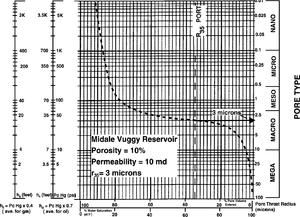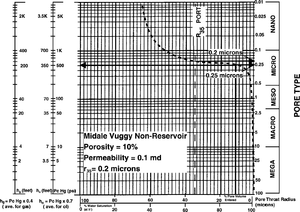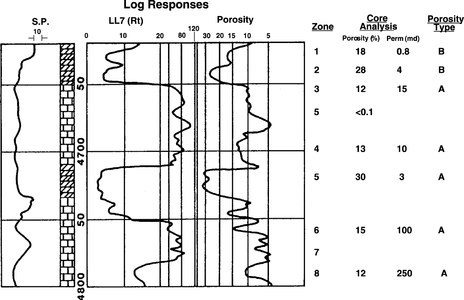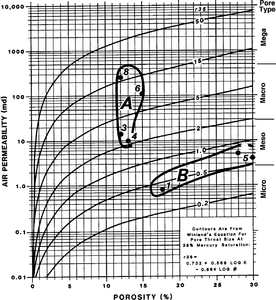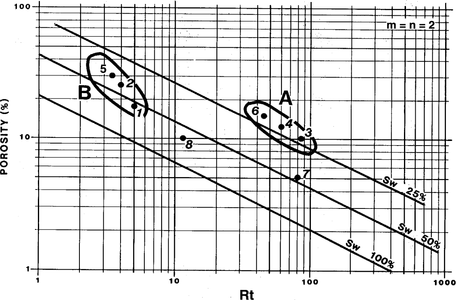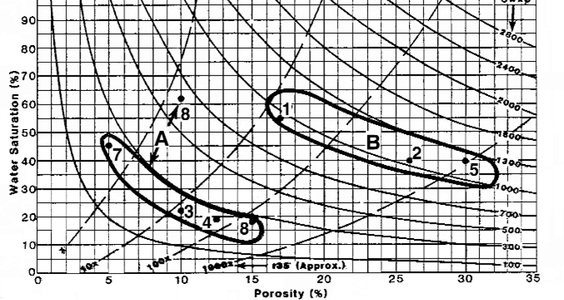Midale lithofacies and distribution
| Exploring for Oil and Gas Traps | |

| |
| Series | Treatise in Petroleum Geology |
|---|---|
| Part | Predicting the occurrence of oil and gas traps |
| Chapter | Predicting reservoir system quality and performance |
| Author | Dan J. Hartmann, Edward A. Beaumont |
| Link | Web page |
| Store | AAPG Store |
Productive facies
The Midale in the Weyburn area is carbonates and evaporites deposited near a low-energy shoreline on a marine ramp. The main producing carbonate facies (vuggy packstone facies) is shoal deposits of fossiliferous, peloidal, Ortonella-bearing nodular wacke-stones to grainstones. The principal occluding cements are sparry calcite and anhydrite.
Reservoir SEM and capillary pressure curve
Figure 1 shows the petrophysical characteristics of the main Weyburn reservoir facies: Ortonella-bearing vuggy wackestones to packstones. The sample is macroporous, its pore system dominated by large pores and pore throats. The capillary pressure curve shows relatively low entry (and presumably breakthrough) pressure. The port size (r35) of the sample is approximately 3μ.
Nonproductive facies
The main nonproductive updip carbonate facies (“porous mudstone”) is locally laminated and burrowed peloidal lime and dolomite mudstones to wackestones. These tighter rocks originated on a low-energy to restricted shelf and in lagoons.
Nonreservoir SEM and capillary curve
Figure 2 illustrates the petrophysical characteristics of the main nonreservoir facies in the field: lime and dolomite mudstones to wackestones. The sample pore system consists of fine intergranular and unconnected vuggy pores and pore throats. The capillary pressure curve shows the higher entry pressure of the nonreservoir facies compared to the reservoir facies. The r35 and r10 values for the sample are 0.2 and 0.25μ, respectively.
Facies tracts of Midale vuggy beds
The Midale vuggy beds contain three facies tracts that parallel the paleo-shoreline (northwest).
- In and downdip from Weyburn field, the rocks consist primarily of the vuggy packstone facies, although there are numerous thin interbeds of porous mudstone facies.
- Landward (now updip) from this facies tract, the reservoir grades into porous mudstone facies with scattered lenses of poorly developed, vuggy packstone facies.
- Still farther northeast but downdip from the truncation edge of the Midale, the rocks change facies into anhydrite.
Overlying and underlying beds
The beds overlying the Midale vuggy beds, i.e., the Midale marly beds, consist almost entirely of the porous mudstone facies. The beds underlying the Midale vuggy beds are tight carbonates and evaporites.
Weyburn well log
Figure 3 example of log characteristics of Midale beds in a Weyburn field well.[1]
Figure 4 Crossplot of routine core porosity and permeability from Midale in an example well at Weyburn field. From Coalson et al.;[2] courtesy RMAG.
Figure 5 Pickett plot for the Midale vuggy beds from an example well in Weyburn field. From Coalson et al.;[2] courtesy RMAG.
Figure 6 Buckles plot for the Weyburn well. From Coalson et al.;[2] courtesy RMAG.
Figure 3 is an example of log characteristics of Midale beds in a Weyburn field well. The well was continuously cored through the Midale interval. The brick pattern denotes packstone facies with vuggy and intergranular porosity; hachures indicate porous dolomitic mudstone facies. Log and core data for representative (if extreme) data points, numbered 1-8, also appear in Figures 4, 5, and 6.
See also
- Weyburn field location and trap problem
- Midale porosity, pore geometries, and petrophysics
- Effect of pore geometry on Sw in midale rocks
- Weyburn seal capacity
- Midale seal capacity and trap type
References
- ↑ Coalson, E. B., D. J. Hartmann, and J. B. Thomas, 1990, Applied Petrophysics in Exploration and Exploitation: Notes from short course sponsored by Univ. of Colo.–Denver, var. pages.
- ↑ 2.0 2.1 2.2 Coalson, E. B., S. M. Goolsby, and M. H. Franklin, 1994, Subtle seals and fluid-flow barriers in carbonate rocks, in J. C. Dolson, M. L. Hendricks, and W. A. Wescott, eds., Unconformity Related Hydrocarbons in Sedimentary Sequences: RMAG Guidebook for Petroleum Exploration and Exploitation in Clastic and Carbonate Sediments, p. 45–58.
